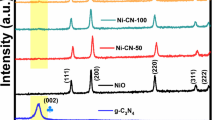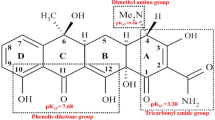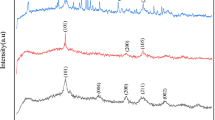Abstract
Herein, the efficient degradation of a highly consumed antibiotic known as metronidazole (MNZ) in aqueous solutions using Co/g-C3N4/Fe3O4 nanocomposite under visible light irradiation was accomplished. Initially, the photocatalyst (Co/g-C3N4/Fe3O4) was synthesized by a simple hydrothermal method and then characterized by several analytical techniques, namely EDS, SEM, XRD, UV–vis DRS, and FTIR. The efficiency of the synthesized photocatalyst with regard to the degradation of the studied antibiotic (MNZ) under visible light irradiation was fully evaluated. The influential operational parameters affecting the efficiency of the degradation process such as pH (2–10), nanocomposite dosage (0.2–1 g/L), MNZ concentration (5–20 mg/L), and irradiation time (0–80 min) were optimized. The results revealed that the maximum degradation efficiency for MNZ was obtained under the following conditions: irradiation time of 60 min, pH = 8, MNZ concentration of 5 mg/L, and photocatalyst dosage of 0.7 g/L. In addition, the degradation of MNZ followed the pseudo-first-order kinetic model. The best rate constant (k) value was determined to be 0.0102 min−1 with the correlation coefficient (R2) of 0.992. According to the results of the quenching tests, it was found out that hydroxyl radicals (OH°) were the main species responsible for the MNZ degradation. Furthermore, the applied photocatalyst (Co/g-C3N4/Fe3O4) exhibited a high level of recovery and stability after five cycles of reuse. Co/g-C3N4/Fe3O4/Vis system exhibited an excellent performance in the treatment of wastewater and real water samples. Finally, it was concluded that the synthesized nanocomposite could be potentially used as a promising and suitable photocatalyst in the degradation of other antibiotics.







Similar content being viewed by others
Data availability
All data generated or analyzed during this study are included in this published article.
References
Abdili T, Fazlzadeh M, Alighadri M, Rahmani K (2017) Efficiency of sonofenton degradation in removal of sulfacetamide from aqueous solutions using nanoscale zerovalent iron particles. J Mazandaran Univ Medical Sci 27:130–146
Ahmadifard T, Heydari R, Tarrahi MJ, Khorramabadi GS (2019) Photocatalytic degradation of diazinon in aqueous solutions using immobilized MgO nanoparticles on concrete. Int J Chem React Eng 17
Ahmed S, Rasul M, Brown R, Hashib M (2011) Influence of parameters on the heterogeneous photocatalytic degradation of pesticides and phenolic contaminants in wastewater: a short review. J Environ Manage 92:311–330
Al Aukidy M, Verlicchi P, Jelic A, Petrovic M, Barcelò D (2012) Monitoring release of pharmaceutical compounds: occurrence and environmental risk assessment of two WWTP effluents and their receiving bodies in the Po Valley, Italy. Sci Total Environ 438:15–25
Alizadeh T, Nayeri S, Habibi-Yangjeh A (2019) Graphitic carbon nitride (g-C3N4/Fe3O4/BiOI)-carbon composite electrode as a highly sensitive and selective citric acid sensor: Three-component nanocomposite as a definitive factor for selectivity in catalysis. Sens Actuators, B Chem 279:245–254
Bahareh K, Habibi MH (2019) High photocatalytic activity of light-driven Fe2TiO5 nanoheterostructure toward degradation of antibiotic metronidazole. J Ind Eng Chem 80:292–300
Bashiri F, Khezri SM, Kalantary RR, Kakavandi B (2020): Enhanced photocatalytic degradation of metronidazole by TiO2 decorated on magnetic reduced graphene oxide: characterization, optimization and reaction mechanism studies. J Molecul Liq 314: 113608
Chen X, Huang G, An C, Yao Y, Zhao S (2018) Emerging N-nitrosamines and N-nitramines from amine-based post-combustion CO2 capture–a review. Chem Eng J 335:921–935
Davari N, Farhadian M, SolaimanyNazar AR (2021) Synthesis and characterization of Fe2O3 doped ZnO supported on clinoptilolite for photocatalytic degradation of metronidazole. Environ Technol 42:1734–1746
Drzewicz P, Trojanowicz M, Zona R, Solar S, Gehringer P (2004) Decomposition of 2, 4-dichlorophenoxyacetic acid by ozonation, ionizing radiation as well as ozonation combined with ionizing radiation. Radiat Phys Chem 69:281–287
Duan S, Han G, Su Y, Zhang X, Liu Y, Wu X, Li B (2016) Magnetic Co@ g-C3N4 core–shells on rGO sheets for momentum transfer with catalytic activity toward continuous-flow hydrogen generation. Langmuir 32:6272–6281
Eswar NK, Katkar VV, Ramamurthy PC, Madras G (2015) Novel AgBr/Ag3PO4 decorated ceria nanoflake composites for enhanced photocatalytic activity toward dyes and bacteria under visible light. Ind Eng Chem Res 54:8031–8042
Ghodsi S, Esrafili A, Kalantary RR, Gholami M, Sobhi HR (2020): Synthesis and evaluation of the performance of g-C3N4/Fe3O4/Ag photocatalyst for the efficient removal of diazinon: kinetic studies. J Photochem Photobiol A: Chem 389: 112279
Gholami P, Khataee A, Soltani RDC, Dinpazhoh L, Bhatnagar A (2020): Photocatalytic degradation of gemifloxacin antibiotic using Zn-Co-LDH@ biochar nanocomposite. J Hazard Mater 382: 121070
González-Pleiter M, Gonzalo S, Rodea-Palomares I, Leganés F, Rosal R, Boltes K, Marco E, Fernández-Piñas F (2013) Toxicity of five antibiotics and their mixtures towards photosynthetic aquatic organisms: implications for environmental risk assessment. Water Res 47:2050–2064
Goswami P, O'Haire T (2016) Developments in the use of green (biodegradable), recycled and biopolymer materials in technical nonwovens, Advances in Technical Nonwovens. Elsevier, pp. 97–114
Guo R, Wang Y, Li J, Cheng X, Dionysiou DD (2020) Sulfamethoxazole degradation by visible light assisted peroxymonosulfate process based on nanohybrid manganese dioxide incorporating ferric oxide. Appl Catalysis B: Environ 278: 119297
Habibi-Yangjeh A, Mousavi M, Nakata K (2019) Boosting visible-light photocatalytic performance of g-C3N4/Fe3O4 anchored with CoMoO4 nanoparticles: novel magnetically recoverable photocatalysts. J Photochem Photobiol, A 368:120–136
He L, Cui B, Liu J, Wang M, Zhang Z, Zhang H (2018) Fabrication of porous CoO x/mC@ MoS2 composite loaded on g-C3N4 nanosheets as a highly efficient dual electrocatalyst for oxygen reduction and hydrogen evolution reactions. ACS Sustain Chem Eng 6:9257–9268
Husain Khan A, Abdul Aziz H, Khan NA, Ahmed S, Mehtab MS, Vambol S, Vambol V, Changani F, Islam S (2020) Pharmaceuticals of emerging concern in hospital wastewater: removal of ibuprofen and ofloxacin drugs using MBBR method. Int J Environ Analytic Chem, 1–15
Jamila GS, Sajjad S, Leghari SAK, Long M (2020) Nitrogen doped carbon quantum dots and GO modified WO3 nanosheets combination as an effective visible photo catalyst. J Hazard Mater 382, 121087
Khan AH, Khan NA, Ahmed S, Dhingra A, Singh CP, Khan SU, Mohammadi AA, Changani F, Yousefi M, Alam S (2020a) Application of advanced oxidation processes followed by different treatment technologies for hospital wastewater treatment. J Cleaner Product 269: 122411
Khan NA, Ahmed S, Farooqi IH, Ali I, Vambol V, Changani F, Yousefi M, Vambol S, Khan SU, Khan AH (2020b) Occurrence, sources and conventional treatment techniques for various antibiotics present in hospital wastewaters: a critical review. TrAC Trends Analytic Chem 129: 115921
Kumar A, Kumar A, Sharma G, Ala’a H, Naushad M, Ghfar AA, Stadler FJ (2018) Quaternary magnetic BiOCl/g-C3N4/Cu2O/Fe3O4 nano-junction for visible light and solar powered degradation of sulfamethoxazole from aqueous environment. Chem Eng J 334:462–478
Kumar S, Kumar B, Baruah A, Shanker V (2013a) Synthesis of magnetically separable and recyclable g-C3N4–Fe3O4 hybrid nanocomposites with enhanced photocatalytic performance under visible-light irradiation. J Phys Chem C 117:26135–26143
Kumar S, Surendar T, Baruah A, Shanker V (2013b) Synthesis of a novel and stable gC 3 N 4–Ag 3 PO 4 hybrid nanocomposite photocatalyst and study of the photocatalytic activity under visible light irradiation. J Mater Chem A 1:5333–5340
Lau P, Augustine CA (2019) Modeling and optimization of the removal of chlorpyrifos and organics reduction from wastewater by Ag/AgBr/TiO2 using the central composite design (CCD). Desalination and Water Treatment 175:90–98
Liu T, Wang L, Lu X, Fan J, Cai X, Gao B, Miao R, Wang J, Lv Y (2017) Comparative study of the photocatalytic performance for the degradation of different dyes by ZnIn 2 S 4: adsorption, active species, and pathways. RSC Adv 7:12292–12300
Luo B, Huang G, Yao Y, An C, Li W, Zheng R, Zhao K (2020): Comprehensive evaluation of adsorption performances of carbonaceous materials for sulfonamide antibiotics removal. Environ Sci Poll Res, 1–15
McBean E (2019) Removal of emerging contaminants: the next water revolution. J Environ Informatics Lett 1:1–7
Mohammadzadeh Kakhki R, Ahsani F (2020) Development of a novel and high performance visible-light-induced Cd3OSO4 nanophotocatalyst for degradation of diazinon. Appl Organometallic Chem, e5770
Moorthy S, Moorthy G, Swaminathan K (2020) Fabrication of novel ZnSeO 3 anchored on gC 3 N 4 nanosheets: an outstanding photocatalyst for the mitigation of pesticides and pharmaceuticals. J Inorganic Organometallic Polymers Mater, 1–13
Mou Z, Zhang H, Liu Z, Sun J, Zhu M (2019): Ultrathin BiOCl/nitrogen-doped graphene quantum dots composites with strong adsorption and effective photocatalytic activity for the degradation of antibiotic ciprofloxacin. Appl Surface Sci 496: 143655
Mousavi M, Habibi-Yangjeh A (2018) Decoration of Fe3O4 and CoWO4 nanoparticles over graphitic carbon nitride: novel visible-light-responsive photocatalysts with exceptional photocatalytic performances. Mater Res Bull 105:159–171
Oh W-D, Lok L-W, Veksha A, Giannis A, Lim T-T (2018) Enhanced photocatalytic degradation of bisphenol A with Ag-decorated S-doped g-C3N4 under solar irradiation: performance and mechanistic studies. Chem Eng J 333:739–749
Pan L-j, Li J, Li C-x, Yu G-w, Wang Y (2018) Study of ciprofloxacin biodegradation by a Thermus sp. isolated from pharmaceutical sludge. J Hazard Mater 343:59–67
Peng J, Wu E, Wang N, Quan X, Sun M, Hu Q (2019) Removal of sulfonamide antibiotics from water by adsorption and persulfate oxidation process. J Mol Liq 274:632–638
Pronk W, Palmquist H, Biebow M, Boller M (2006) Nanofiltration for the separation of pharmaceuticals from nutrients in source-separated urine. Water Res 40:1405–1412
Pronk W, Zuleeg S, Lienert J, Escher B, Koller M, Berner A, Koch G, Boller M (2007) Pilot experiments with electrodialysis and ozonation for the production of a fertiliser from urine. Water Sci Technol 56:219–227
Sarker M, Bhadra BN, Seo PW, Jhung SH (2017) Adsorption of benzotriazole and benzimidazole from water over a Co-based metal azolate framework MAF-5 (Co). J Hazard Mater 324:131–138
Song Y, Qi J, Tian J, Gao S, Cui F (2018) Construction of Ag/g-C3N4 photocatalysts with visible-light photocatalytic activity for sulfamethoxazole degradation. Chem Eng J 341:547–555
Sraw A, Kaur T, Pandey Y, Verma A, Sobti A, Wanchoo R, Toor A (2020) Photocatalytic degradation of monocrotophos and quinalphos using solar-activated S-doped TiO 2. Int J Environ Sci Technol 17:4895–4908
Tamaddon F, Mosslemin MH, Asadipour A, Gharaghani MA, Nasiri A (2020) Microwave-assisted preparation of ZnFe2O4@ methyl cellulose as a new nano-biomagnetic photocatalyst for photodegradation of metronidazole. Int J Biol Macromol 154:1036–1049
Topkaya E, Konyar M, Yatmaz HC, Öztürk K (2014) Pure ZnO and composite ZnO/TiO2 catalyst plates: a comparative study for the degradation of azo dye, pesticide and antibiotic in aqueous solutions. J Colloid Interface Sci 430:6–11
Wan Z, Wang J-L (2016) Removal of sulfonamide antibiotics from wastewater by gamma irradiation in presence of iron ions. Nucl Sci Tech 27:104
Wang X, Du Y, Ma J (2016) Novel synthesis of carbon spheres supported nanoscale zero-valent iron for removal of metronidazole. Appl Surf Sci 390:50–59
Wen J, Xie J, Chen X, Li X (2017) A review on g-C3N4-based photocatalysts. Appl Surf Sci 391:72–123
Wood A, Giersig M, Mulvaney P (2001) Fermi level equilibration in quantum dot− metal nanojunctions. J Phys Chem B 105:8810–8815
Wu C, Kuo C, Dong C, Chen C, Lin Y (2019) Removal of sulfonamides from wastewater in the UV/TiO2 system: effects of pH and salinity on photodegradation and mineralization. Water Sci Technol 79:349–355
Yang Z, Xu X, Liang X, Lei C, Cui Y, Wu W, Yang Y, Zhang Z, Lei Z (2017) Construction of heterostructured MIL-125/Ag/g-C3N4 nanocomposite as an efficient bifunctional visible light photocatalyst for the organic oxidation and reduction reactions. Appl Catal B 205:42–54
Yin R, Guo W, Wang H, Du J, Zhou X, Wu Q, Zheng H, Chang J, Ren N (2018) Selective degradation of sulfonamide antibiotics by peroxymonosulfate alone: direct oxidation and nonradical mechanisms. Chem Eng J 334:2539–2546
Zangiabadi M, Shamspur T, Saljooqi A, Mostafavi A (2019): Evaluating the efficiency of the GO-Fe3O4/TiO2 mesoporous photocatalyst for degradation of chlorpyrifos pesticide under visible light irradiation. Appl Organometallic Chem 33: e4813
Zangiabadi M, Saljooqi A, Shamspur T, Mostafavi A (2020) Evaluation of GO nanosheets decorated by CuFe2O4 and CdS nanoparticles as photocatalyst for the degradation of dinoseb and imidacloprid pesticides. Ceram Int 46:6124–6128
Zhang W, Zhou L, Deng H (2016) Ag modified g-C3N4 composites with enhanced visible-light photocatalytic activity for diclofenac degradation. J Mol Catal a: Chem 423:270–276
Zhang Y, Wu J, Deng Y, Xin Y, Liu H, Ma D, Bao N (2017) Synthesis and visible-light photocatalytic property of Ag/GO/g-C3N4 ternary composite. Mater Sci Eng, B 221:1–9
Zhou B, Zhao X, Liu H, Qu J, Huang C (2010) Visible-light sensitive cobalt-doped BiVO4 (Co-BiVO4) photocatalytic composites for the degradation of methylene blue dye in dilute aqueous solutions. Appl Catal B 99:214–221
Zhou R, Li T, Su Y, Ma T, Zhang L, Ren H (2018) Oxidative removal of metronidazole from aqueous solution by thermally activated persulfate process: kinetics and mechanisms. Environ Sci Pollut Res 25:2466–2475
Zhu Z, Tang X, Fan W, Liu Z, Huo P, Wang T, Yan Y, Li C (2019) Studying of Co-doped g-C3N4 and modified with Fe3O4 quantum dots on removing tetracycline. J Alloy Compd 775:248–258
Funding
The authors would like to gratefully appreciate the Iran University of Medical Sciences for the provision of financial supports (Grant No. 99-3-61-20007).
Author information
Authors and Affiliations
Contributions
Mojtaba Yeganeh: Investigation/writing original draft, formal analysis methodology. Hamid Reza Sobhi: Conceptualization, writing-reviewing and editing. Ali Esrafili: Visualization, writing original draft/review and editing, supervision.
Corresponding author
Ethics declarations
Ethics approval
Not applicable.
Consent to participate
Not applicable.
Consent for publication
Not applicable.
Competing interests
The authors declare no competing interests.
Additional information
Responsible Editor: Sami Rtimi
Publisher's note
Springer Nature remains neutral with regard to jurisdictional claims in published maps and institutional affiliations.
Supplementary Information
Below is the link to the electronic supplementary material.
Rights and permissions
About this article
Cite this article
Yeganeh, M., Sobhi, H.R. & Esrafili, A. Efficient photocatalytic degradation of metronidazole from aqueous solutions using Co/g-C3N4/Fe3O4 nanocomposite under visible light irradiation. Environ Sci Pollut Res 29, 25486–25495 (2022). https://doi.org/10.1007/s11356-021-17077-2
Received:
Accepted:
Published:
Issue Date:
DOI: https://doi.org/10.1007/s11356-021-17077-2




